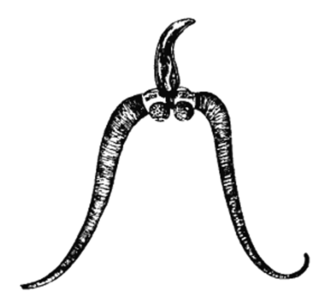
Digenea is a class of trematodes in the Platyhelminthes phylum, consisting of parasitic flatworms with a syncytial tegument and, usually, two suckers, one ventral and one oral. Adults commonly live within the digestive tract, but occur throughout the organ systems of all classes of vertebrates. Once thought to be related to the Monogenea, it is now recognised that they are closest to the Aspidogastrea and that the Monogenea are more closely allied with the Cestoda. Around 6,000 species have been described to date.

Trematodes are parasitic flatworms of the class Trematoda, specifically parasitic flukes with two suckers: one ventral and the other oral. Trematodes are covered by a tegument, that protects the organism from the environment by providing secretory and absorptive functions.

Plagiorchiida is a large order of trematodes, synonymous to Echinostomida. They belong to the Digenea, a large subclass of flukes. This order contains relatively few significant parasites of humans.

Bucephalus polymorphus is a type of flatworm. This species is within the Bucephalidae family of Digenea, which in turn is a subclass of Trematodes within the phylum Platyhelminthes. It is characterized by having a mouth near the middle of its body, along with a sac-like gut. The mouth opening is located in the centre of the ventral surface. This is a specific body type of cecaria known as a gastrostome.

Opisthorchiidae is a family of digenean trematodes. Opisthorchiidae have cosmopolitan distribution.

Clinostomum marginatum is a species of parasitic fluke. It is commonly called the "Yellow grub". It is found in many freshwater fish in North America, and no fish so far is immune to this parasite. It is also found in frogs. Clinostomum marginatum can also be found in the mouth of aquatic birds such as herons and egrets. They are commonly present in the esophagus of fish-eating birds and reptiles. Eggs of these trematodes are shed in the feces of aquatic birds and released into water. Aquatic birds become hosts of this parasite by ingesting infected freshwater fish. The metacercariae are found right beneath the skin or in the muscles of host fish.

The Bucephaloidea are a superfamily of trematode flatworms, belonging to the large group Digenea. Many species are endoparasites of mollusks and fish. The name Bucephalus meaning "ox head" was originally applied to the genus Bucephalus because of the horn-like appearance of the forked tail (furcae) of its cercaria larva. By what Manter calls a "curious circumstance", horns are also suggested by the long tentacles of adult worms.

Bucephalus is the genus name for many trematode flatworms that are parasites of molluscs and fish. Like other Bucephalidae, they are found in fish both as adults and as metacercariae. In marine and freshwater teleosts, they live as parasites inside the digestive tract, especially the intestine.

Bucephalidae is a family of trematodes that parasitize fish. They lack suckers, having instead a muscular organ called a "rhynchus" at the front end which they use to attach to their hosts. The characteristics of the rhynchus are used to help define the genera of the family. It is one of the largest digenean families, with 25 genera containing hundreds of described species. Bucephalids are cosmopolitan, having been recorded all over the world. They are parasites of fish from freshwater, marine, and brackish water habitat types.

Gastrodiscoides is genus of zoonotic trematode under the class Trematoda. It has only one species, Gastrodiscoides hominis. It is a parasite of a variety of vertebrates, including humans. The first definitive specimen was described from a human subject in 1876. It is prevalent in Bangladesh, India, Burma, China, Kazakhstan, Philippines, Thailand, Vietnam, and the Volga Delta of Russia, with isolated cases from Africa, such as Nigeria. It is especially notable in the Assam, Bengal, Bihar, Madhya Pradesh, Orissa and Uttar Pradesh regions of India.

Opecoelidae is a family of trematodes. It is the largest digenean family with over 90 genera and nearly 900 species, almost solely found in marine and freshwater teleost fishes. It was considered by Bray et al. to belong in the superfamily Opecoeloidea Ozaki, 1925 or the Brachycladioidea Odhner, 1905.

Hamacreadium is a genus of trematodes in the family Opecoelidae. It is synonymous with Olivacreadium Bilqees, 1976. Species of Hamacreadium are endoparasitic in fish such as Lethrinus Cuvier, 1829.
Cainocreadium is a genus of trematodes in the family Opecoelidae. It has been synonymised with Apopodocotyle Pritchard, 1966, Cainocreadoides Nagaty, 1956, and Emmettrema Caballero y Caballero, 1946.
Coitocaecum is a genus of trematodes in the family Opecoelidae. It has been synonymised to Ozakia Wisniewski, 1934, Paradactylostomum Zhukov, 1972 nec Toman, 1992, and Pseudocoitocaecum Bilqees, 1972.
Opecoeloides is a genus of trematodes in the family Opecoelidae. It has been synonymised with Cymbephallus Linton, 1934 and Fimbriatus von Wicklen, 1946.
Aephnidiogenidae is a family of trematodes in the order Plagiorchiida.
Diplasiocotyle is a genus which belongs to the family Microcotylidae and class Monogenea. As all Monogenea, species of Microcotylidae are ectoparasites that affect their host by attaching themselves as larvae on the gills of the fish and grow into adult stage. This larval stage is called oncomiracidium, and is characterized as free swimming and ciliated.
Neopodocotyle is a genus of trematodes in the family Opecoelidae.
Derogenidae is a family of trematodes belonging to the order Plagiorchiida.

Creptotrema is a genus of Trematoda belonging to the family Allocreadiidae.










